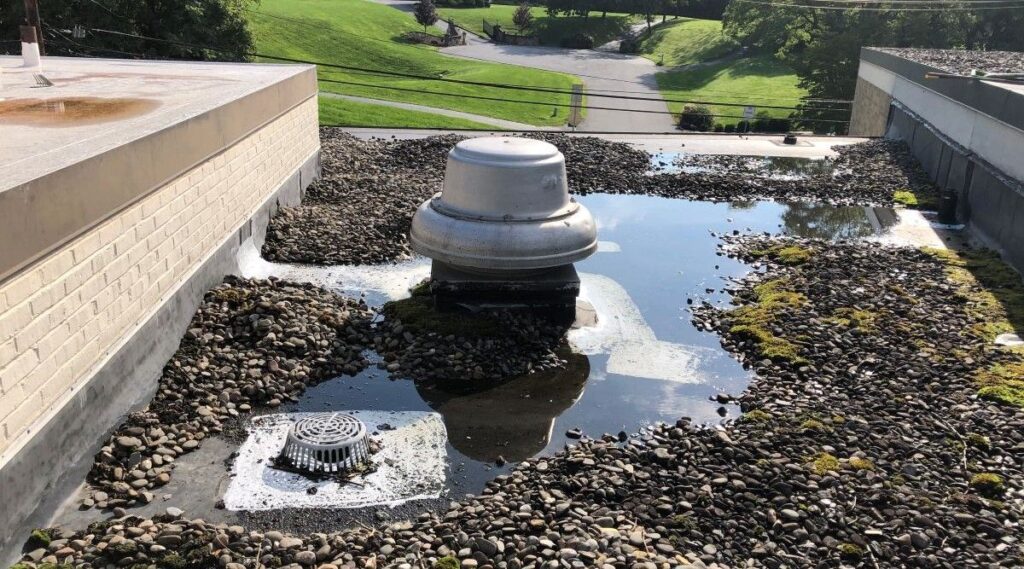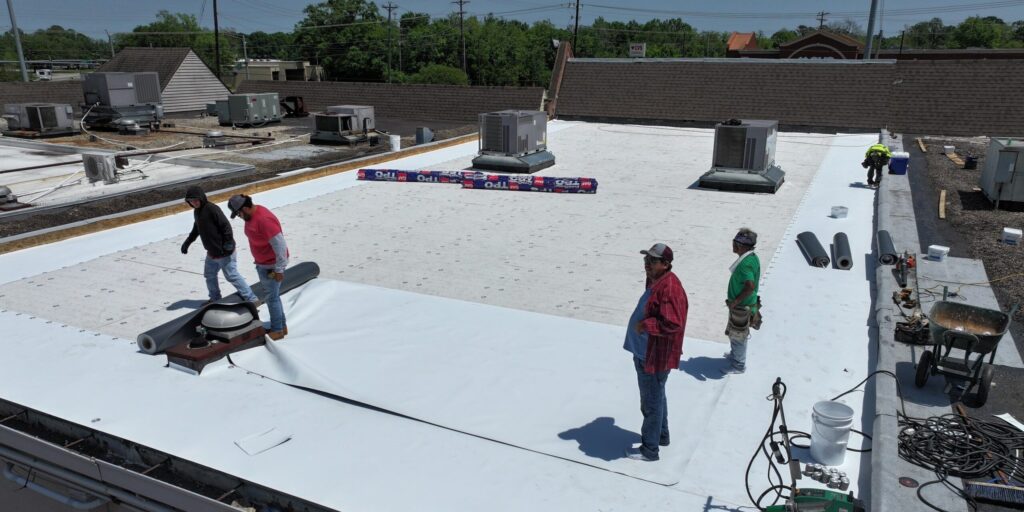Flat roofs can be a stylish and modern choice for many homes, but they often come with a unique set of challenges, especially when it comes to drainage. If you’ve noticed water pooling on your flat roof, you’re not alone. This common issue, known as “ponding water,” can lead to significant problems if not addressed promptly. Let’s dive into why flat roofs might not drain properly and what you can do to protect your home.
The Dangers of Ponding Water
Imagine a small pond sitting on your roof. While it might seem harmless at first, this standing water can cause a cascade of issues for your residential home.
- Structural Damage: The sheer weight of accumulated water can put immense stress on your roof’s structure. Over time, this can lead to sagging, weakened support beams, and even collapse, especially on porch roofs that might not be designed to sustain such loads.
- Water Leaks: Ponding water significantly increases the risk of leaks. Constant exposure to moisture can degrade roofing materials, leading to cracks and openings that allow water to seep into your home, causing damage to ceilings, walls, and insulation.
- Material Degradation: Roofing materials, even those designed for flat roofs, can break down faster when constantly submerged in water. This can lead to premature aging, blistering, and a shorter lifespan for your roof.
- Mold and Mildew Growth: Stagnant water creates an ideal breeding ground for mold and mildew, which can not only damage your roof but also pose health risks to your family.
- Pest Infestations: Ponding water can attract unwanted pests like mosquitoes, which thrive in standing water.

The Importance of Design and Drainage
A well-designed roof, regardless of its style, should always have proper drainage in mind. For flat roofs, this means ensuring a slight slope, even if it’s not immediately visible, to direct water towards drainage points.
The Silent Blockers: Tree Branches and Pine Needles
Nature, while beautiful, can be a flat roof’s worst enemy when it comes to drainage.
- Valleys and Low Spots: Your roof likely has valleys or low spots designed to channel water. However, fallen leaves, tree branches, and especially pine needles can easily accumulate in these areas, creating dams that prevent water from flowing freely.
- Gutters and Downspouts: If you have gutters and downspouts, they can also become clogged with debris, rendering them ineffective.
The Solution: Regularly inspect and clear your roof, especially valleys, low spots, and gutters, of any debris. Keeping these sections clear is crucial for maintaining proper water discharge.
The Hidden Hazard: Roof Overlays
Sometimes, homeowners opt for a roof overlay, which involves installing a new layer of roofing material over an existing one. While this might seem like a cost-effective solution, it can create significant problems for flat roofs.
- Limited Water Flow: Overlays can inadvertently create new low spots or reduce the existing slope, further impeding water flow and exacerbating ponding issues.
- Against Code: Many building codes prohibit multiple roof layers, especially on flat roofs, due to the added weight and potential for drainage problems.
- Structural Strain: Your home’s framing makeup is designed to support a specific weight. Adding multiple layers of roofing material can exceed this design capacity, leading to structural strain and potential collapse.
Slope and Pitch: Why They Matter
When we talk about roofs, “slope” and “pitch” are critical terms. Slope refers to the angle of the roof, while pitch is a numerical representation of that angle.
- IRC Code: The International Residential Code (IRC) specifies that shingle roofs are only viable for roofs with a slope greater than 2/12. This means for every 12 units of horizontal run, the roof must rise at least 2 units vertically. Flat roofs, by definition, have a much lower slope, which is why traditional shingles are not suitable.
- Porch Roofs: Porch roofs, often overlooked, also need to be properly sloped during construction to ensure adequate drainage. A poorly sloped porch roof can not only lead to ponding water but also compromise its structural integrity, potentially leading to collapse.

Enhancing Drainage: Gutters and Downspouts
For areas with high water flow, adding or improving your gutter and downspout system can be a game-changer. These systems are designed to collect rainwater and direct it away from your home’s foundation, preventing erosion and water damage.
Adjusting to the Challenge: Proper Flat Roofing Systems
If your flat roof is consistently experiencing drainage issues, it might be time to consider a change in your roofing system.
- Silicone Coating vs. Acrylic Coating: While acrylic coatings are popular, they are not always the best choice for roofs with ponding water. Acrylics can break down when constantly submerged. A silicone coating, on the other hand, is designed to sustain ponding water without degradation, offering a more durable and long-lasting solution for flat roofs. This type of coating creates a seamless, waterproof membrane that can withstand the challenges of standing water.
Your Roof, Your Home, Your Peace of Mind
Understanding why your flat roof might not be draining properly is the first step towards protecting your home. From regular maintenance to considering a more robust roofing system, there are solutions available. Don’t let ponding water compromise the safety and longevity of your home.
Call to Action: For expert advice and solutions tailored to your flat roof drainage needs, contact Browns Roofing today! We’re here to help homeowners like you find lasting peace of mind.
